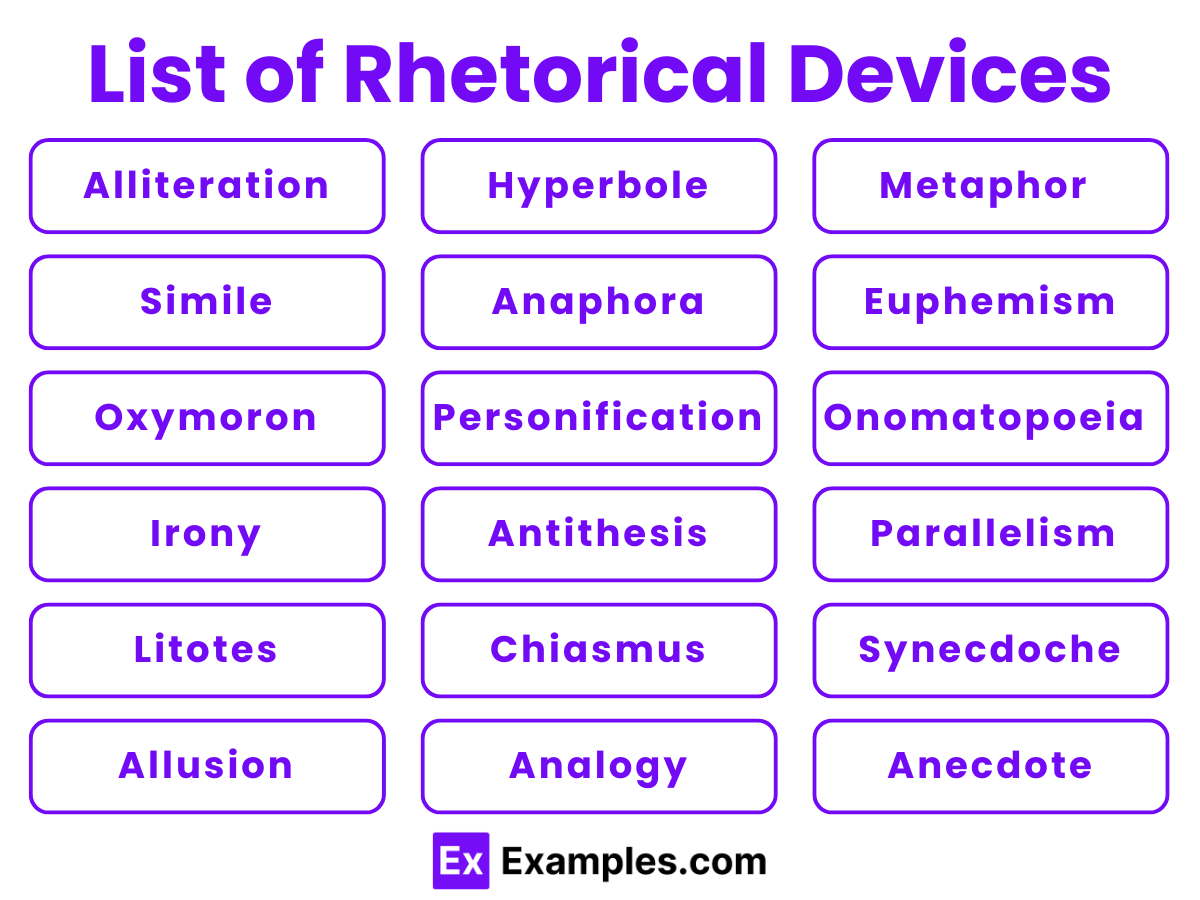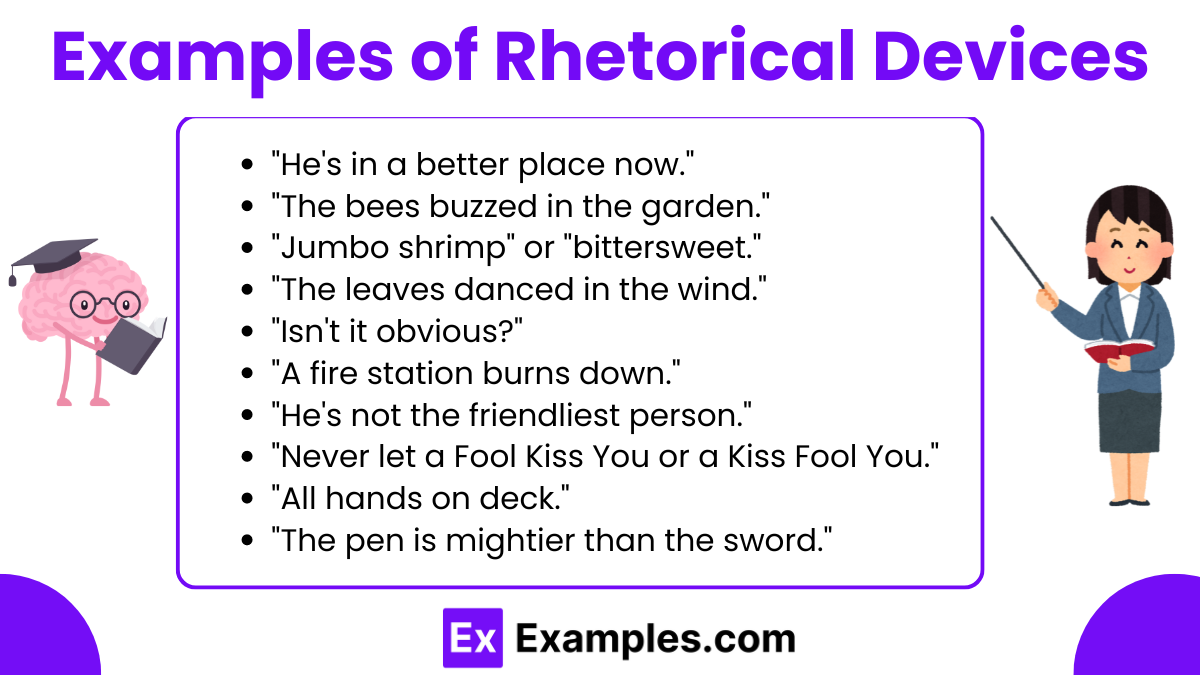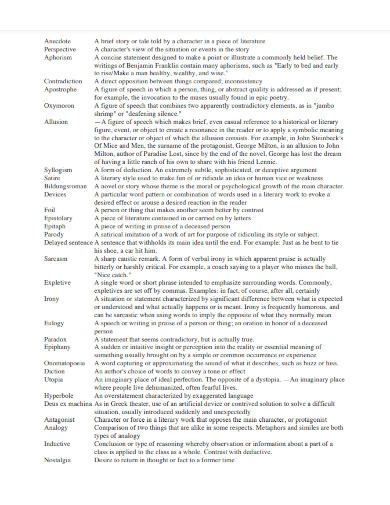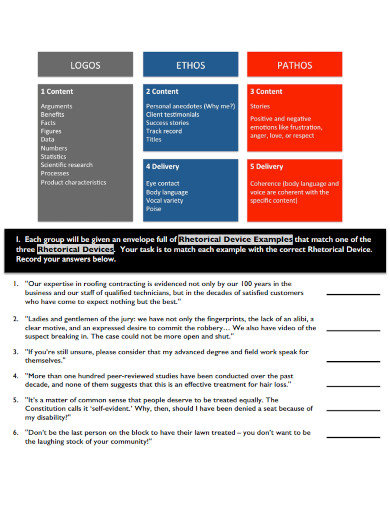60+ Rhetorical Device Examples
Rhetorical devices are techniques that writers and speakers use to persuade, inform, or entertain their audience in English. These tools enhance communication by adding emphasis, clarity, and beauty to the language. Common rhetorical devices include metaphors, similes, alliteration, and hyperbole. Understanding and using these devices can make your writing and speech more compelling and effective. Whether you’re crafting an essay, delivering a speech, or simply trying to make a point, mastering rhetorical devices can significantly improve your ability to connect with and influence others.
What is a Rhetorical Devices?
List of Rhetorical Devices

- Alliteration: The repetition of the same initial consonant sound in a series of words. Example: “She sells seashells by the seashore.”
- Hyperbole: An exaggerated statement used for emphasis or effect. Example: “I’ve told you a million times.”
- Metaphor: A figure of speech that directly compares two unlike things by stating one is the other. Example: “Time is a thief.”
- Simile: A comparison between two unlike things using “like” or “as.” Example: “Her smile was as bright as the sun.”
- Anaphora: The repetition of a word or phrase at the beginning of successive clauses. Example: “We shall fight on the beaches, we shall fight on the landing grounds.”
- Euphemism: A mild or indirect word or expression substituted for one considered too harsh or blunt. Example: “Passed away” instead of “died.”
- Onomatopoeia: A word that imitates the sound it represents. Example: “Buzz,” “clang,” “sizzle.”
- Oxymoron: A figure of speech that combines contradictory terms. Example: “Bittersweet,” “deafening silence.”
- Personification: Attributing human characteristics to non-human entities. Example: “The wind whispered through the trees.”
- Rhetorical Question: A question asked for effect, not requiring an answer. Example: “Isn’t it a bit late to start now?”
- Irony: A contrast between expectation and reality, often highlighting the opposite of what is meant. Example: Saying “What a pleasant day” during a storm.
- Antithesis: Juxtaposing contrasting ideas in balanced phrases or clauses. Example: “It was the best of times, it was the worst of times.”
- Parallelism: The use of successive verbal constructions that correspond in grammatical structure. Example: “Easy come, easy go.”
- Litotes: An understatement in which an affirmative is expressed by negating its opposite. Example: “Not bad” meaning “good.”
- Chiasmus: A rhetorical or literary figure in which words or concepts are repeated in reverse order. Example: “Ask not what your country can do for you—ask what you can do for your country.”
- Synecdoche: A figure of speech in which a part represents the whole or vice versa. Example: “All hands on deck” means all people on deck.
- Metonymy: Substituting the name of one object with another closely associated with it. Example: “The White House issued a statement” instead of “The President issued a statement.”
- Allusion: A brief and indirect reference to a person, place, thing, or idea of historical, cultural, literary, or political significance. Example: “He was a real Romeo with the ladies.”
- Analogy: A comparison in which an idea or a thing is compared to another thing that is quite different from it. Example: “Just as a sword is the weapon of a warrior, a pen is the weapon of a writer.”
- Anecdote: A short, amusing or interesting story about a real incident or person, often used to illustrate a point. Example: Telling a personal story to make a larger argument.
Examples of Rhetorical Devices in Sentences

- “Peter Piper picked a peck of pickled peppers.”
- “I’m so hungry I could eat a horse.”
- “The classroom was a zoo.”
- “Her cheeks are red like roses.”
- “Every day, every night, in every way, I am getting better and better.”
- “He’s in a better place now.”
- “The bees buzzed in the garden.”
- “Jumbo shrimp” or “bittersweet.”
- “The leaves danced in the wind.”
- “Isn’t it obvious?”
- “A fire station burns down.”
- “It was the best of times, it was the worst of times.”
- “She likes cooking, jogging, and reading.”
- “He’s not the friendliest person.”
- “Never let a Fool Kiss You or a Kiss Fool You.”
- “All hands on deck.”
- “The pen is mightier than the sword.”
- “He was a Good Samaritan yesterday when he helped the lady start her car.”
- “Finding a good man is like finding a needle in a haystack.”
- “When I was a child, my family and I would go to the beach every summer, and one time, a seagull stole my sandwich right out of my hand.”
Examples of Rhetorical Devices in Literature
- “From forth the fatal loins of these two foes; A pair of star-cross’d lovers take their life.” – Romeo and Juliet by William Shakespeare
- “I had to wait in the station for ten days—an eternity.” – Heart of Darkness by Joseph Conrad
- “But soft, what light through yonder window breaks? It is the east, and Juliet is the sun.” – Romeo and Juliet by William Shakespeare
- “Elderly American ladies leaning on their canes listed toward me like towers of Pisa.” – Lolita by Vladimir Nabokov
- “It was the best of times, it was the worst of times, it was the age of wisdom, it was the age of foolishness…” – A Tale of Two Cities by Charles Dickens
- “The wind stood up and gave a shout. He whistled on his fingers and Kicked the withered leaves about And thumped the branches with his hand.” – Wind by James Stephens
- “If you prick us, do we not bleed? If you tickle us, do we not laugh? If you poison us, do we not die? And if you wrong us, shall we not revenge?” – The Merchant of Venice by William Shakespeare
- “Go ask his name: if he be married. My grave is like to be my wedding bed.” – Romeo and Juliet by William Shakespeare
- “It was the best of times, it was the worst of times, it was the age of wisdom, it was the age of foolishness…” – A Tale of Two Cities by Charles Dickens
- “Parting is such sweet sorrow.” – Romeo and Juliet by William Shakespeare
Examples of Rhetorical Devices in AP Lang
- “All animals are equal, but some animals are more equal than others.” – Animal Farm by George Orwell
- “The only thing we have to fear is fear itself.” – Franklin D. Roosevelt
- “I came, I saw, I conquered.” – Julius Caesar
- “That’s one small step for man, one giant leap for mankind.” – Neil Armstrong
- “It was the best of times, it was the worst of times, it was the age of wisdom, it was the age of foolishness…” – A Tale of Two Cities by Charles Dickens
- “I have a dream that one day this nation will rise up and live out the true meaning of its creed: ‘We hold these truths to be self-evident, that all men are created equal.'” – Martin Luther King Jr.
- “The pen is mightier than the sword.” – Edward Bulwer-Lytton
- “To be, or not to be: that is the question.” – Hamlet by William Shakespeare
- “Ask not what your country can do for you—ask what you can do for your country.” – John F. Kennedy
- “Good fences make good neighbors.” – Mending Wall by Robert Frost
Difference Between Rhetorical Device and Literary Device
| Aspect | Rhetorical Device | Literary Device |
|---|---|---|
| Purpose | Used to persuade, influence, or appeal to an audience’s emotions and logic. | Used to enhance storytelling, create imagery, and add depth to the narrative. |
| Application | Common in speeches, essays, advertisements, and other persuasive texts (e.g., anaphora, rhetorical questions). | Found in novels, poems, short stories, and other literary works (e.g., symbolism, allegory). |
| Focus | Focuses on the impact of words on the audience, aiming to persuade or influence. | Focuses on the narrative structure and artistic quality of the writing. |
| Techniques | Enhances argumentation and communication (e.g., repetition, analogy). | Enhances aesthetic and emotional experience (e.g., imagery, personification). |
| Usage | Used by speakers, writers, and advertisers to make arguments compelling and memorable (e.g., hyperbole, ethos). | Used by authors and poets to create rich, engaging narratives (e.g., irony, alliteration). |
| Impact | Aims for a direct impact on thoughts, feelings, and actions (e.g., rhetorical questions, anecdotes). | Aims to create a lasting impression and deepen understanding (e.g., foreshadowing, motifs). |
| Examples | “I have a dream” (anaphora) by Martin Luther King Jr. | “It was the best of times, it was the worst of times” (antithesis) in A Tale of Two Cities by Charles Dickens. |
1. Rhetorical Devices List
ns_row class=”row”]
[/ns_row]2. Rhetorical Devices Practice
How to Use Rhetorical Devices
Rhetorical devices are very useful as they can improve one’s ability to organize and lead people to reach a specific goal, tone, objective, or decision.
Step 1: Research or Look Up A List of Rhetorical Devices
Begin by researching or looking up a list of rhetorical devices you can use and integrate into your writing and/or speaking. This will help you have a reference within arms reach.
Step 2: Outline How You Will Use the Chosen Rhetorical Devices
After researching or obtaining a list of rhetorical devices, you must now choose specific rhetorical devices you want to incorporate into your outputs. Not only that, but you must also outline how you are going to use them, to ensure that you are utilizing them to the highest extent.
Step 3a: If Spoken, Practice Speaking Using the Rhetorical Device
If you are planning to integrate rhetorical devices into your speech, then you must practice using rhetorical devices in your everyday conversations and dialogues. By properly practicing the rhetorical device, then you will be able to organically integrate said device into your speech.
Step 3b: If Written, Use the Rhetorical Device on the Written Output
If you are planning on using the chosen rhetorical device/s in your writing, then you must properly practice integrating it into your writing. Doing this will allow you to organically write using rhetorical devices without it looking very forced or out of place.
Tips for Using Rhetorical Devices
- Know Your Audience: Tailor your rhetorical devices to resonate with your audience’s values, beliefs, and interests.
- Use Sparingly: Avoid overloading your text with too many rhetorical devices, which can overwhelm the reader.
- Enhance Your Message: Select devices that naturally strengthen your argument or narrative.
- Create Vivid Imagery: Employ devices like metaphors, similes, and personification to paint a vivid picture in the reader’s mind.
- Add Rhythm and Flow: Use alliteration and parallelism to create a pleasing rhythm and enhance readability.
- Evoke Emotion: Choose devices like hyperbole and rhetorical questions to evoke emotions and engage your audience emotionally.
- Highlight Contrasts: Use antithesis and oxymoron to highlight contrasts and create a striking effect.
- Be Clear and Concise: Ensure your rhetorical devices clarify rather than obscure your message.
- Practice and Revise: Experiment with different devices and revise your work to see which ones work best.
What is the strongest rhetorical device?
Metaphor is often considered the strongest rhetorical device for its ability to create vivid imagery and convey complex ideas succinctly.
What are the top three rhetorical devices?
The top three rhetorical devices are metaphors, anaphora, and rhetorical questions. They enhance persuasion, emphasize points, and engage the audience effectively.
How to identify rhetorical devices?
Identify rhetorical devices by analyzing the text for patterns, repeated phrases, comparisons, and questions that enhance the argument or narrative.
Is allusion a rhetorical device?
Yes, allusion is a rhetorical device that references a well-known person, place, event, or work to add deeper meaning to the text.
Is flashback a rhetorical device?
No, flashback is a literary device, not a rhetorical device. It involves a narrative technique that recounts events from the past.
What is a hyperbole in rhetoric?
A hyperbole is an exaggerated statement used for emphasis or humor in rhetoric, making a point more forcefully.
Is hyperbole a rhetorical device?
Yes, hyperbole is a rhetorical device that uses exaggeration to emphasize a point or evoke strong feelings.
Is personification a rhetorical device?
Yes, personification is a rhetorical device that gives human characteristics to non-human entities to create vivid imagery.
Is assonance a rhetorical device?
Yes, assonance is a rhetorical device that involves the repetition of vowel sounds within words to create rhythm and mood.
What are the Synonyms of Rhetorical Devices?
Synonyms of rhetorical devices include figures of speech, literary techniques, stylistic devices, and persuasive tools.





